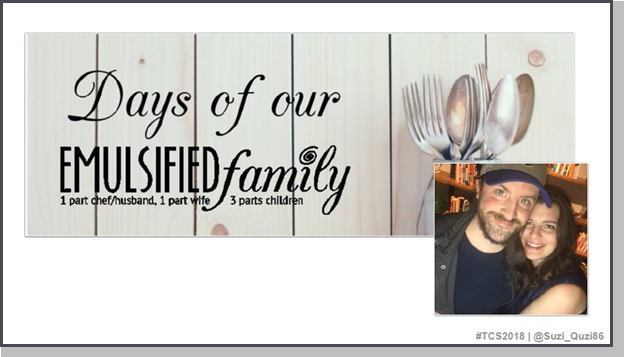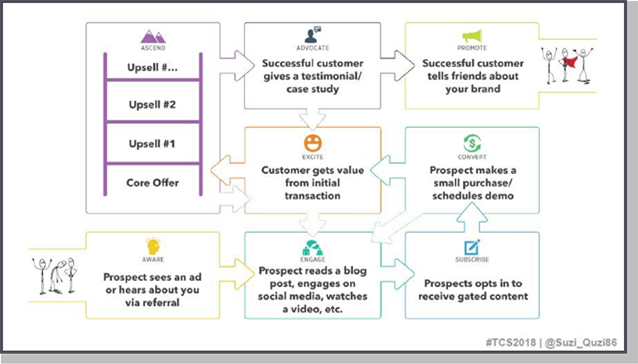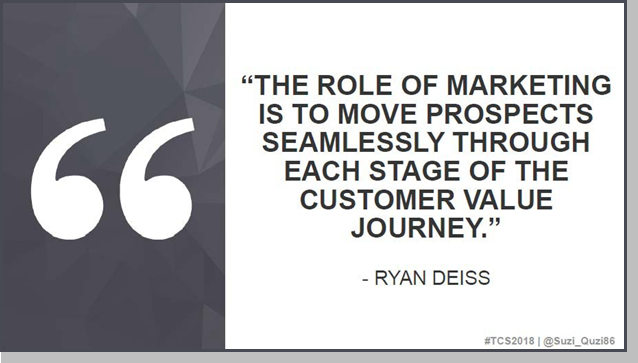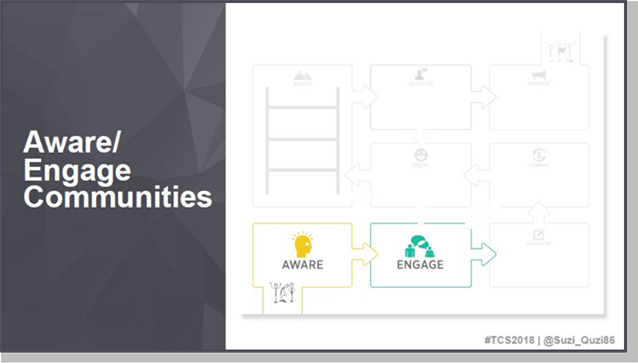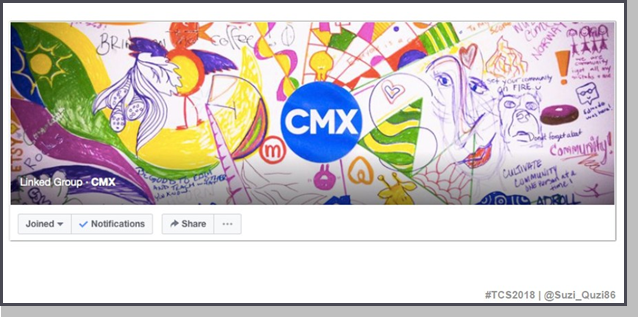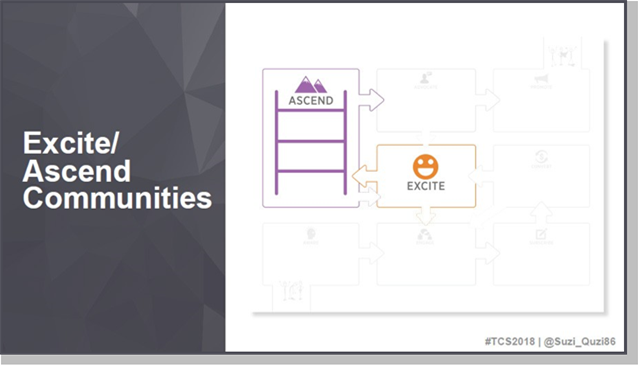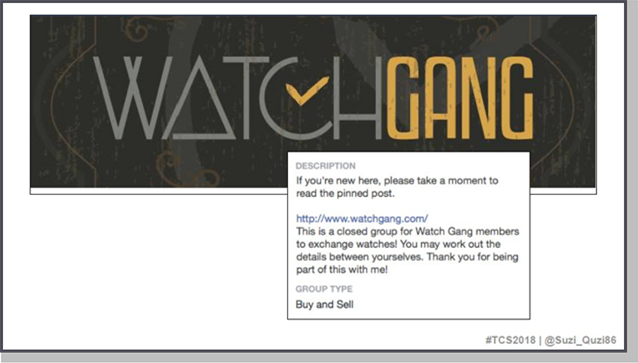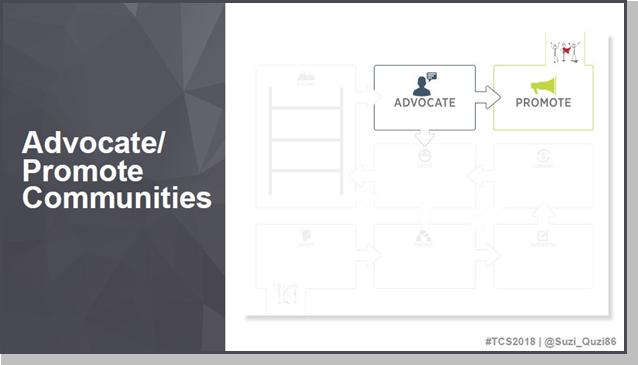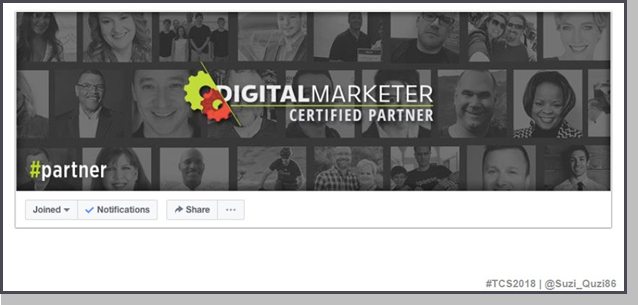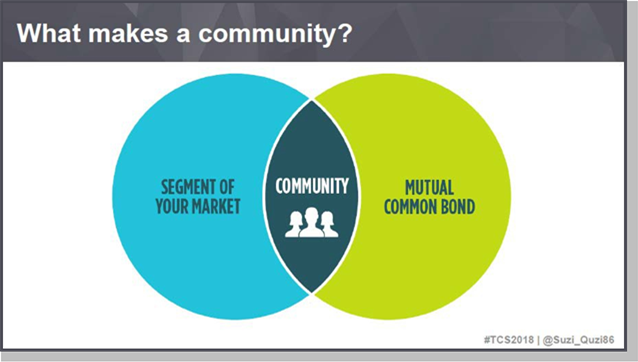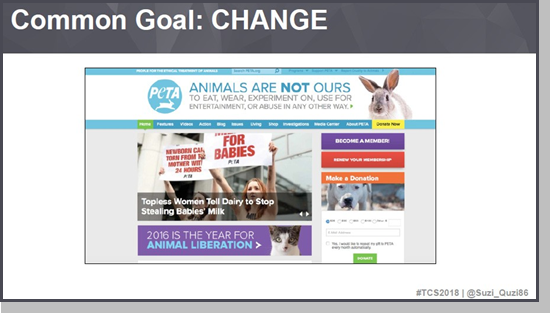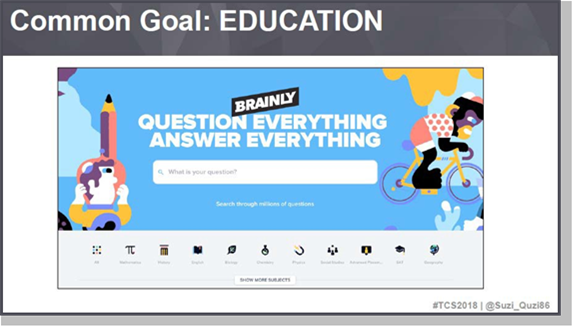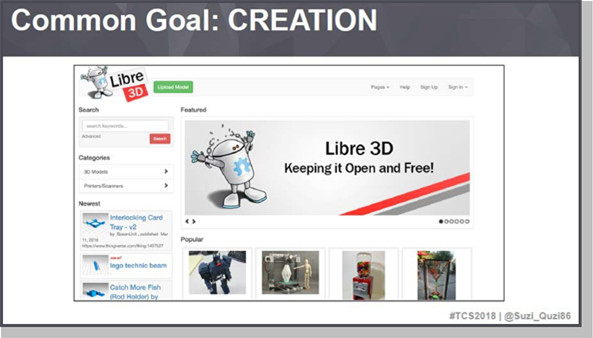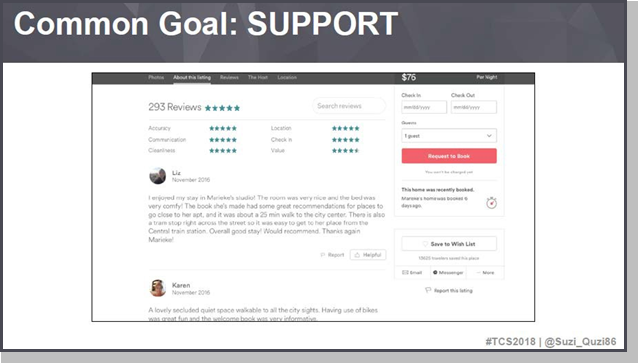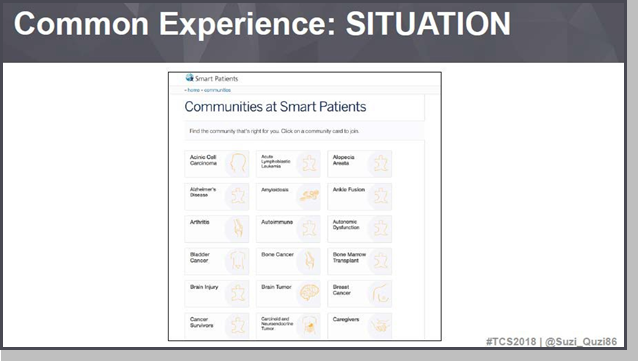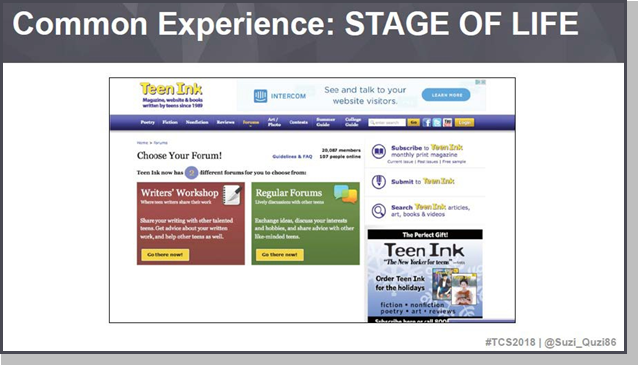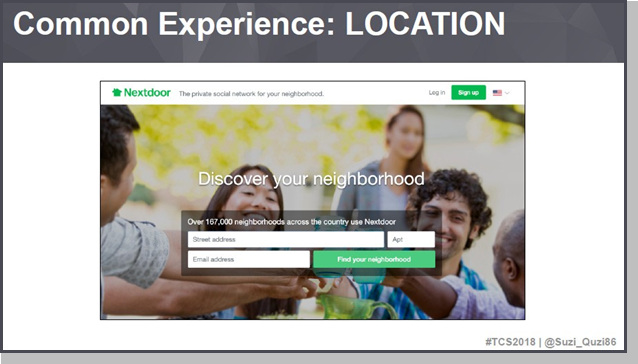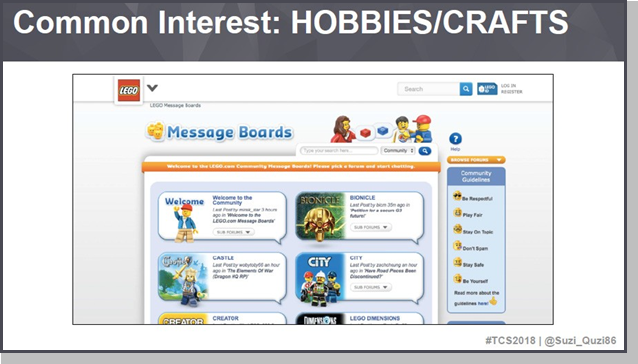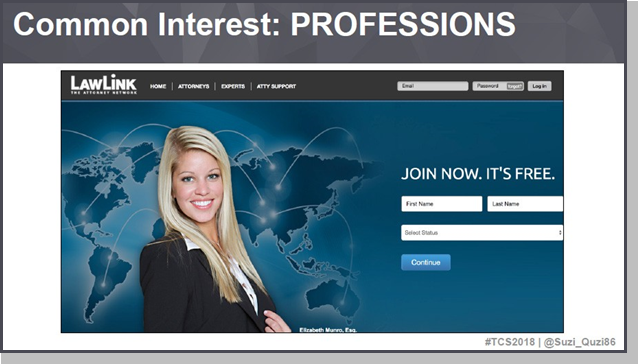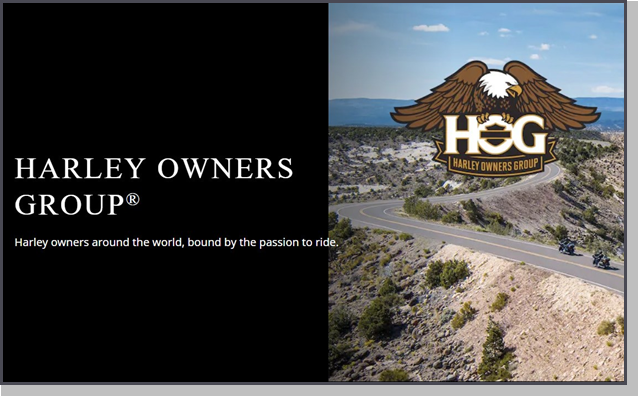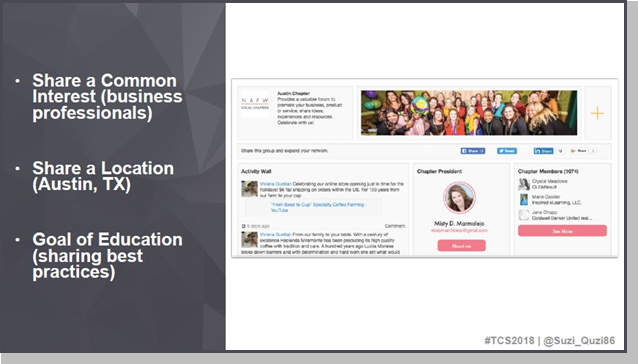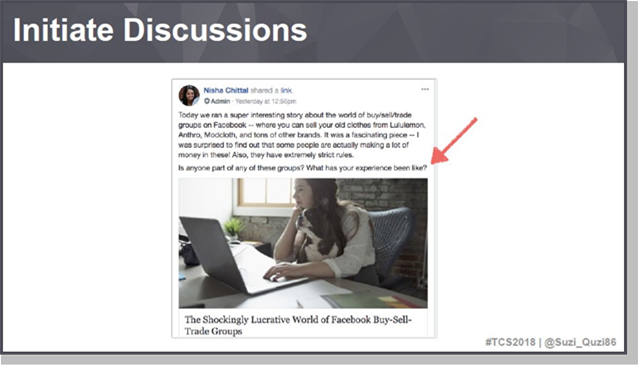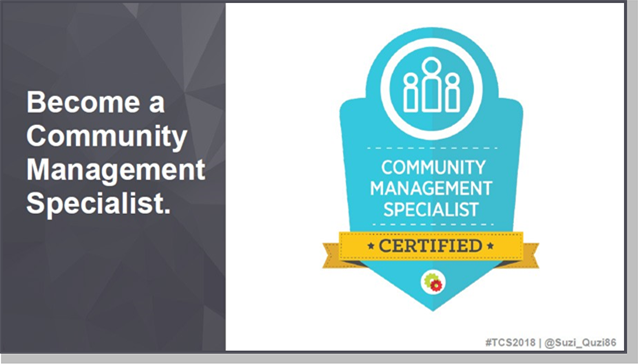Suzi Nelson
Suzi Nelson is the Lead Community Strategist at DigitalMarketer. She has a degree in Journalism (Strategic Communications) from the University of Kansas and is an avid defender of the Oxford comma. You can find Suzi connecting with our customers in our Facebook mastermind groups.
Today we’re going to talk about how to create and build a Facebook group, a community that grows, leads sales and loyalty. I’m Suzi. I’m the community strategist at DigitalMarketer.
That means I build and manage all DigitalMarketer’s online customer communities. I’ve certified over a thousand people in community management through DigitalMarketer’s certification course. And I was awarded Community Manager of the Year 2017 by CMAD, is an independent group of community professionals.
I want to start out this session with a question for all of you guys. Are you a member of a Facebook Group? Everybody, right? I’m a member of some Facebook groups too, believe it or not. I’m not just an admin, although that is what I do all day.
One of the groups that I’m in is Cool Dog group. This is one of those groups that has thousands and thousands of people in it; and all the members do all day long is post really cute pictures of puppies. I actually am probably a member of about five to seven groups just like this because I am a total dog person. These are my dogs. The fuzzy one is Oscar and the other one is Charlie. And they are the best dogs on the face of the planet. Sorry if you have a dog, mine win.
I don’t participate in these groups that often. I’m what the Internet would call a lurker in these communities because I just really enjoy the content. I don’t really post. I might like a picture every now and again or tag a friend if I think they will enjoy it. But I don’t really participate in the dog groups that I’m in.
Now I’m also a member of a Facebook group called Emulsified Family. This is a really small group. It’s probably only a few hundred people. This is run by a blogger named Jennifer Keen Small. What Emulsified Family basically is, is a support group for people who are dating or are married to chefs. That describes me as well. This is me and my husband. He is an executive chef at a local hotel in Austin, Texas where we live. And there are a lot of unique challenges and rewards whenever you’re married to someone who works in the food industry. Namely, the hours are very, very challenging and long. So, I connect with other people in this group who understand the situation that I’m in.
It’s not all just complaining about hours and things like that. Every year, around Christmas time, we’ll share the gifts that we have bought our significant others and kinda crowdsource ideas. It really is like a little family. Now I’m much more likely to participate in a Facebook group like this because it’s very close to my identity than, say, just happening to like dogs with a bunch of other people.
I’m a member of a ton of other Facebook Groups too. Groups that connect me to other people in my profession, other community managers, and I’m in tons of different digital marketing groups so I can get to know digital marketers in other spaces and other niches. In fact, the average Facebook user is a member of 30 Facebook groups. There’s a big but after that.
They only consider two to three of those groups to be meaningful. And what I mean by meaningful is that not only does it become a core part of your experience on Facebook, you know, you’re looking out for that content, but it also becomes a part of your real-world support structure.
Now Facebook is rapidly approaching two billion users all over the world. And for the last year or so, they have completely doubled down on getting their members connected to groups that they find meaningful. Just last fall, Facebook hosted Communities Summit where they gathered up admins of these meaningful Facebook groups just to talk about their experience. And Mark Zuckerberg said this, he said, “In six months, we’ve helped 50% more people find meaningful communities on Facebook than had joined in the history of the product.”
That’s huge. Facebook just turned 14 years old earlier this month. So, they’ve been using their AI in six months to connect people to these meaningful communities. These communities that people want to participate in and find a real value in.
Making a Facebook Group Meaningful
For this presentation, I’m going to talk about how you can make a Facebook group meaningful. Now a lot of this stuff can apply to any platform so don’t just limit yourself just to Facebook Groups. If you want to explore other community platforms because a lot of this stuff will apply across the board.
The first thing we need to know is what a community is and what it isn’t. Early on, when we first started our Facebook Group, Russ Henneberry and I used to have really long discussions about what made a community and how it was different from social media. The big difference is that community is not an audience. This is your quintessential audience when you think of it. They’re there to consume something. They’re there to read content or your blog posts or receive a marketing message. That’s not what community is all about.
Community looks more like this. It’s people talking to each other and collaborating and creating something that didn’t exist before and sharing ideas and sharing their knowledge. It’s a very one-to-one conversation with people. So, if you have a Facebook Group or any community platform, and the conversation is mainly between you and your members in a back and forth kind of conversation, that’s most likely more of an audience and that’s okay, if that’s your goal. But that’s not what makes a true community.
True communities happen when the conversation is mainly between your members of the community if they’re doing most of the talking and they’re talking to each other and building relationships. That’s where some
community magic can really start to happen and where that meaningful value starts to build up.
Brand communities are so powerful because they take those transactional customer relationships and turn them into emotional relationships that last longer and are much, much stronger. Transactional relationships are you give me money so I’m going to give you a product. And that’s kind of the end of the exchange. Or you give me your email address and I’ll give you a piece of content, right? That’s very transactional. With community, you can turn that into an emotional relationship that people can really cling to with their identity.
Community Customer Value Journey
Whenever we’re talking about building valuable communities, the first thing you need to determine is how will community bring value to your business. Because if you haven’t nailed that part down yet, you’re going to get frustrated really quick, putting a lot of time and energy into a Facebook Group and not understanding where it fits in your business or life. So we’re going to touch on that.
This is the customer value journey.
This is the process that moves someone from a complete stranger who’s never heard of you before all the way to a raving fan. I am not going into a lot of detail about this, but if you want to learn more, check this post by our Ryan Deiss, CEO of DigitalMarketer: Build Loyalty, Leads, & Sales in Your Community Using the Customer Value Journey.
In that post, Ryan really dives in and explains it all, but here’s a quick overview and it kinda goes in a step-by-step fashion:
- It starts out in the aware stage. This is when a prospect just becomes aware that you exist, whether that’s by seeing an ad or maybe they got a referral for you from one of their friends.
- Then they move on to engage. This is when they start to experience more touchpoints with your brand. They’re reading your blog. They’re watching videos. They’re engaging with you on social media. They are just trying to get to know you a little bit better before they make a commitment.
- Then they’re ready for subscribe and that’s when a prospect opts in to receive gated content. They’re now on your list.
- That’s whenever you can convert them, so that’s what gets every marketer excited. That’s when they actually make that purchase, schedule a demo, make a sign of commitment to your brand.
• If they get value, they move to the excite stage.
- And that primes them for ascension so that’s your core offer in all your up-sales.
- If they still have a great experience, that’s when they move on to advocacy. That’s when you start hearing testimonials and getting case studies from successful customers.
- And then it ends on promote. That’s when they had such a great experience with your brand that they start telling all their friends and family about you.
So that’s the process of moving someone from complete stranger to raving fan. That’s the customer value journey.
Ryan Deiss teaches us that the role of marketing is to move prospects seamlessly through each stage of the customer value journey. Now notice that it says the role of marketing, not the role of community. That’s no one community can move people all the way through the entire customer value journey. Don’t make a Facebook group your entire marketing plan. It can fit in certain ways, but it’s just a link in your marketing chain. You’re still going to have to use things like email marketing or content marketing, SEO. You’re still going to have to do those things.
Don’t try to move people all the way through the value journey using a community because if you want to build a true community, it’s probably not the best place for direct sales, which is kind of important for building a business. Rely on other elements of your marketing mix for that.
Now through my research over the last few years, I figured out that brands tend to position community in one of three places in this customer value journey. The first are aware and engage communities. These are Facebook Groups, if you will, that meet people at the beginning of their journey with your brand. So, they’re just becoming aware that you exist and they’re looking to get to know you and your mission a little bit better.
A good example of this is the CMX Facebook Group. CMX is a company that gives training to community managers like me. They also host a summit of their own every year, but you don’t have to be a CMX customer to join this Facebook Group. Any community professional is welcome and it’s a way that people network and ask questions and kind of crowd source troublesome issues that they might come across. And they’re getting to know the CMX brand at the same time. So whenever their event does roll around, they can announce that it’s coming and people are much more likely to purchase those tickets because they’re getting to know the CMX brand through this group.
But this is definitely positioned as an aware, engage community. They’re not trying to upsell their customers. They’re not trying to equip their advocates. They’re just trying to tap into people who are just becoming aware that CMX exists.
The next area that communities tend to position their communities is the excite and ascend stages of the customer value journey. These are your customer communities. If you guys have a continuity program or a membership product, positioning community as part of that is a smart move. It gets people excited and builds the value. And it primes them for all that wonderful ascension.
An example of this is the Watch Gang Facebook Group. Watch Gang is a subscription service and they send out a fancy watch every month to their members. And they created this Facebook Group so that if you happened to not like your watch that month, you can contact other members and arrange a trade or sell your watch.
I’ve snooped around in this group a little bit and they also talk about just their love for watches. They really nerd out about it and it’s great. This is an excite and ascend community. They’re not trying to tap into their prospects. They’re trying to excite their members.
The third area that brands tend to use community is the advocate and promote area of the customer value journey. This is all about equipping and encouraging your advocates and your promoters to spread the good news about your brand.
An example of this is our own Certified Partner Facebook Group. The DigitalMarketer Partner Program are marketers and agencies who have joined us on our mission and they help other businesses implement the strategies that we teach. So we created this Facebook group to help them connect and share best practices. We’re not trying to sell in this group. We’re not trying to make them aware of more DigitalMarketer products. They’re already customers, so let’s talk about best practices, let’s talk about what’s going on in your agency, let’s talk about the cool things that you’re doing. So that’s meeting them at the advocate and promote area of the customer value journey because that’s what the DM Certified Partner program is to us.
If you want to learn more about positioning community in the customer value journey, Ryan’s blog post that I mentioned earlier, really dives into this concept. It provides examples, so you can really wrap your head around positioning community.
Okay, so now let’s talk about how will your community bring value to your members? Because remember Facebook isn’t going to put a lot of that artificial intelligence to connect people to your group if they don’t think that your group finds it meaningful. And that means people are engaging, they’re finding value in it. So we’re going to talk about all the ways you can position your community toward your members to encourage that kind of environment.
The good news is that communities are not hard to understand as far as a base definition goes. It’s just a group of people with something in common. And where those two elements meet, that’s where community happens. This Venn diagram highlights that.
It’s just a segment of your market because, you know, if your community is going to build business value which is probably made up of some area of your target market, and a mutual common bond.
To define the segment of your market, look to your customer avatars. I believe most of your guys probably already have in your mind a list of customer avatars that you tend to market to, but in case you need to clarify it a little more, I’m going to point you to this other blog post that has a worksheet you can download: The Customer Avatar Worksheet: Finally, Get Clear on WHO You Are Selling To! It will teach you how to fill it out so you can nail down your target audience.
Keep your customer avatars in mind as I’m going through this presentation because that’s kind of the pool you’re going to draw from whenever you’re thinking about all the ways you can position your community to make it meaningful to them.
Okay, so now let’s talk about that mutual common bond. People naturally form communities around what they have in common. That’s the key to building a really strong community on any platform. If you understand what brings your community together, it’s going to be easier to find your members. It’s going to be easier to talk to them about things that they care about and it’s going to be super easy to keep them engaged and getting value out of that group.
So lucky for us and everyone here, behavior psychologists have already done all the hard work for us and figured out all the elements that tend to make people come together and form communities. And they tend to focus around three different areas: common goals, common experiences, and common interests. So your members will have to have one of these or all of these in common for any community to be meaningful to them. We’re going to break that down even more, so get ready.
Key Element of Communities: Common Goals
First, let’s talk about all the different common goals that people tend to rally around. The first common goal that people tend to rally around online or offline is change. If your avatars want to change something about their industry or their world or even their town, that’s a very uniting experience.
You’re going to find out that people really want to talk about that and bond together and make some change in their world.
Common Goal: Change
An example of that is PETA, People for the Ethical Treatment of Animals. They’re a pretty infamous non-profit and they are on a mission to change the way the world thinks about the way they treat animals. It’s a very uniting experience for those members. They’re very passionate about it.
So especially if you have a non-profit that centers on change, you already
have your community. You just need to tap into it.
Common Goal: Education
Another common goal that tends to unite people is education. If your members have experiences to share and they feel like they can learn from other people’s experiences, that can be very, very bonding.
An example of this is Brainly. Brainly focuses on the education space. So you can see along the bottom here you can just choose your topic, you know, mathematics or history or English. And whenever you click on that, you’ll be immediately connected to other members who are interested in learning about the same thing and you can share resources and learn together. So education can be a very powerful common goal to unite people together.
Common Goal: Creation
The next common goal that tends to bring people together is creation.
It would be kind of difficult to … You’d have to be creative, I guess, to apply this to a Facebook group, but I wanted to be sure to mention it because it’s also a thing that really brings people together. These are your open source communities. All the members are there to create something that didn’t exist before.
This is Leaver 3D. It’s a 3D printing community. All the members have 3D printers and they’re making their own models and then they’re uploading all the patterns for those models so that other people can make them and improve them or change them or create something totally new with those patterns. The goal here is creation. A very, very uniting experience if you’re working with someone to create something.
Common Goal: Support
The last common goal that tends to unite people is support. So, this would include all of the review sites. Below is a screenshot from Airbnb. The thing with support is that it’s people trying to help each other go through the same process or achieve the same objective. Probably book clubs would fall into a community of support because you’re reading the same chapters, you’re discussing it, you’re going through that same process together.
So, if there’s something that your customer avatars can go through together, position your Facebook Group that way. It will be very, very bonding for them to be able to ask questions, to leave their experiences and their reviews. It can be very, very powerful and engaging.
Here’s some questions you can ask yourself if your avatars share a common goal:
- Is there something in their industry, profession, or life that they want to change?
- Is there something they could help others learn more about or something they would like to learn more from others in a very collaborative space?
- Is there something specific that they could work together to create?
- And can they exchange information on a specific objective or process?
That’s all the ways that you can unite your members around a common goal.
Key Element of Communities: Common Experiences
Now let’s talk about common experiences.
Common Experience: Situation
The first way people tend to bond around common experiences is that they share a specific situation. It’s even more powerful if that situation is something that’s beyond their control. This is Smart Patients and they have a ton of communities that are around illnesses.
Just think if you or someone that you knew had a very rare disease, it would be very supportive for them if they could go online and find other people who were going through the same thing that they were because none of their circle is.
That’s where these communities really come into play. It could be communities for divorcees, or people who had a parent pass away, or anything like that. So, if your avatars share a situation, especially if it’s something outside of their control, that would be a very powerful way to position your Facebook group to tap into those members.
Common Experience: Stage of Life
The next experience that people tend to rally around is stage of life. This is Teen Ink. It’s for writers who are also teenagers.
If your customer avatars are sharing the same stage of life or approaching the same milestone, maybe they’re all approaching retirement, that can be very, very bonding because you have to kinda make the same kind of decisions and ask the same kinds of questions. They can really have a lot of conversation around that. So, think about if they share a stage of life.
Common Experience: Location
Location is a big one, especially the smaller the location, the more bonding that community experience is because you know the same landmarks. You know the same street names. You know the same crazy neighbor that plays their music at three a.m. It can be very bonding to make a location-based community.
This is Next Door and they will connect you to people down to your zip code. But you can totally do that with Facebook groups. If your avatars live in the same city, you brick-and-mortar people should totally be tapping into that because Facebook is also placing an emphasis on location-based communities. So, if they live in the same city, the same country, or other geographical locations, that could be a great way to show people that they have a lot in common with each other.
Here are some questions you can ask yourself if your avatars share a common experience:
- Do they share a specific circumstance that’s outside of their control?
- Do they share a specific stage of life or are they entering a milestone in
their life?
- Do they live in the same city, state, country, or other geographical area?
These are all things you can put in the description area of your Facebook Group so people will know immediately what all they have in common with everybody else there. Makes it much easier for them to talk to each other.
Key Element of Communities: Common Interests
Okay, now let’s talk about common interests.
Common Interests: Hobbies and Crafts
The first common interest that’s really uniting are hobbies and crafts. Lego
is really, really big into this. This is a screenshot of their message boards. If you guys haven’t seen it already, there’s a wonderful film called A Lego Brickumentary, and it’s all about how they tapped into their adult Lego enthusiasts and pretty much saved Lego in the ‘90s whenever their business was going under. They tapped into that customer community and kind of doubled-down on connecting those people with each other.
So, hobbies and crafts can be very, very uniting. People love talking about stuff that they’re passionate about, especially if it’s something they love to do in their free time. So that’s a very, very uniting experience as well.
Common Interests: Professions
You guys all know this, professions are very, very bonding. You know, sometimes whenever you’re talking to your friends about your job and they’re not into marketing, you can kind of like watch their eyes glaze over and they just get really bored. And you just keep talking because you have to get it out.
But whenever go to events with other marketers, it’s just so refreshing because everybody gets it. They speak your language. They have the same profession. And it’s very comfortable there, you know, this is your family.
They get you. They get this whole process that you’re going through. So, professions can be very, very bonding.
This is LawLink, this is the attorney network. So this is where attorneys can go geek out about attorney stuff, whatever boring crap that’s about (laughing).
So that’s if your community members share a profession.
Here are the questions you can ask yourself for your avatars:
- Do they share a common interest?
- Is there a specific hobby that they’re passionate about?
- Do they share a specific profession or career?
- Do they share a particular lifestyle or social identity?
Harley-Davidson is amazing at the lifestyle community. They have a group called Hog, Harley owners group, and you have to buy a Harley to get
- They ask for the VIN number, it’s crazy. They’re very protective of their community. But they totally tap into the lifestyle. I am a Harley-Davidson owner. There’s lots of leather jackets. I actually signed up for their community because I wanted to check it out. And they sent me patches in the mail and pins; they’re so cool.
Think about if there’s a particular lifestyle that all your avatars share. That’s something that they want to talk about with other people who get them. You kind of want to position your Facebook groups to where when your members see it, they’re like, “Oh, I’m home. These are my people.”
All this stuff will help you. The good news is, well maybe not so good news if your brain is hurting right now. Your community can be a hybrid of all of these types. It doesn’t have to be just one thing. You can narrow it down so much that you can create something totally and completely unique to your target market.
Here’s an example. This is the National Association of Professional Women, Austin Chapter. So all of these members share a common interest. They’re all business professionals. They’re all women. They also share a location. They all live in Austin, Texas. And you could probably argue that they have a goal of education as they’re sharing best practices and sharing their experiences and learning from each other through that exchange.
So you can make a hybrid of these community types. But I promise, if you pull from these types and apply them to your avatars, you’re going to find that people want to talk about this stuff because it’s something that taps into their identity.
So, what’s missing from all of these different ways you can position your community? Oh yeah, a product purchase.
Now, product purchases are totally fine if that’s like a barrier to get into your Facebook group. That’s what we do at DigitalMarketer. People have to purchase a DigitalMarketer Lab membership to get into the DM Engage Facebook group. It’s fine if that’s the barrier. But don’t make that the only
stinking thing that your community members have in common with each other.
I’m sure you guys do amazing work, but nobody wants to talk about your products all day long on a Facebook group. Product purchases alone aren’t enough, at least not on their own. Your members have to share a common goal, a common experience, or a common interest.
I mentioned on DM Engage people have to purchase a DigitalMarketer Lab membership to join the community. We don’t make them talk about Lab all day long. We don’t have to talk about anything to do with digital marketing because we want them to grow their business. We want them to share their experiences and learn from each other and teach other people their experiences.
Sometimes whenever you’re trying to learn something and get it in your head, try going out and teaching it to someone else. You’ll get to know and understand it better yourself and it’s an amazing process. Make sure that they have something in common other than just happening to have purchased the same product.
Three Community Content “Must Do’s”
Okay, so now let’s touch a little bit on community content because once you have figured out how to position your group to your business and once you’ve figured out how to position the group to your members so that they’re getting value, there probably is a couple of pieces of content you’re going to need in place to kind of get things rolling.
Community Guidelines
The first important piece of content is guidelines. Everybody’s probably going to have to have some sort of guidelines available in your group, especially if it’s more of an open group where anybody can join. But any group, regardless, needs a little bit of guidelines. It kind of sets your community culture. It lets people know what’s allowed and what’s not. But also kind of what this community experience thing is like.
I love this one from Digg. I don’t know if you guys have heard me talk about guidelines before but I often say don’t make it a list of dos and don’ts because that’s boring and it feels really abrasive. People are like, “Oh, there’s just so many, I don’t know what to do.” And people tend to find loopholes in that, like, “Well, it doesn’t technically say I can’t do this.” And then it’s just a pain to moderate.
I usually suggest that people make true guidelines where instead of a list of dos and don’ts, you say, “This is how we expect our members to behave,” and kind of frame it that way. But I love this screenshot from Digg because it kinda falls right in the middle of those two philosophies. So, they do have an okay, not okay, but they provide examples of what’s good and what’s not and what’s welcome and what’s not in their community. So okay, “I respectfully disagree.” Not okay, “I respectfully disagree, you dirty explicative.” You can visually see what’s okay and what’s not.
The only other thing I wanted to say about guidelines is that this is a living document. You’re going to want to go back and check these out quite often and make sure that it’s still aligning because communities are kind of like organisms. As you add new people, it grows and ebbs and flows and you’ll get strong personalities and different situations. And sometimes the whole culture can change because just new people come in and kind of shift it, which is totally cool. But you’re going to have to go and look at those guidelines and make sure they still align with what your community is all about.
Initiate Discussions
Another thing you’re probably going to have to do, especially when you first launch, is initiate discussions. Even though people know they have a lot in common, it can still be really scary to just join a group and say “hi” to a bunch of strangers and start telling them your life story. So sometimes you have to initiate the conversation.
I love this example. This is from a Facebook Group by Racked which is an online retail clothing store. They have a Facebook Group called the Racked Shopping Lounge and one of their admins posted a blog post. But a big mistake I see brands making when they’re creating these groups is they’ll treat it like an audience and just broadcast a blog post. “Hey guys, a new blog post is up. Go check it out.” And that’s kind of the end of the conversation. Always try to pair it with a discussion question. Get your members talking to each other. Get them sharing their ideas and their viewpoints and getting to know each other better.
So, I love this because she did include that discussion question. She didn’t just say, “Hey everyone, we ran an interesting story. Here it is. Why don’t you go check it out?” And that’s kind of the end. She said, “Is anyone part of these groups that we mentioned in this article? What has your experience been like?” And that kicks off a conversation and people start talking and engaging with that.
Beware of Fluff Posts
Fluff posts are something that might build a whole lot of engagement in your group but it doesn’t have any substance and it kinda disappears like this cotton candy that this raccoon is trying to wash. It’s super cute, right? I was really happy when I put that in there.
Fluff posts is another common mistake I see new community managers making. They are looking in their Facebook group. They’re like, “Gosh, nobody’s talking. I need to get people engaged. I need to see that spike in activity.” So, they’ll post something silly like, “Hey everybody, what’s your favorite color?” And it doesn’t have anything to do with anything. And people might respond to that. They might start sharing their favorite colors but it’s not adding any value to the community. People are going to forget about that conversation three seconds after they comment.
Another example would be, “Hey everybody, post a picture of what you had for breakfast today.” And your Facebook group has nothing to do with food or breakfast or anything.
Now it’s okay to do fun things every now and then. At DM Engage, we do, once a month or so, we do a puppy post on Fridays. But even then, I try to position it. You know I love puppies. Even then I try to position it to our marketers by saying, “Hey, everybody needs to blow off some steam. It’s been a long week. You guys have been working hard. I would like to see a picture of your fuzzy little office mate.” So, everyone will start uploading pictures of their dogs and it’s the most wonderful thread of the year. But I
know that the purpose of that isn’t for the engagement boost. It’s just a fun thing to do on a Friday. So that’s okay if you realize what’s happening.
Whenever you’re running these Facebook Groups, you don’t want to look for huge spikes and low lows in engagement. You want to see things leveling out a little bit. Whenever you’re making those fluff posts, you’re just gaming the system. The spikes look really cool on paper. You’re like, “Yes, my community is so engaged. Everyone’s participating.” But the next day, nobody’s going to come back because that didn’t build any value in your group.
So, pay attention to the discussion that you’re starting. Sustain the discussions that are happening. If you see a really good discussion going on and you see it kind of petering out, jump back in and ask somebody, “Hey, can you elaborate on this? Can you tell me more about this experience?” Or tag another member in and say, “Hey, I know that you know a lot about this. I think that you should really weigh in because your insights would be valued.”
That’s the kind of stuff that people want to see in these Facebook groups. They want to share their knowledge and talk to each other and really bond over their common experiences.
So, I hope your brain doesn’t hurt too bad with all of that. It’s a lot to take in. We do have a certification. We released it last fall, around November, so you can become a Community Management Specialist. This is something that I worked probably about a year on. One of the main topics of this training is how moderation is a big part of managing any kind of community.
Here’s some more of what this certification covers:
- The Five Point Conflict Resolution plan that trains you to identify and resolve conflicts.
- Two Methods for Getting Your First Members Whether or Not You Have a List.
- The Community Topic Map that you can use to initiate engaging discussions that your community members actually want to talk about.
- How to Leverage Content that taps into something called sense of community, which is how your members feel about being a part of your group. And Leverager’s Relationship Model which is powerful to meet people at all stages of community membership from newcomers to salty veterans.
- www.digitalmarketer.com
- www.cmxhub.com
- Customer Avatar Worksheet


